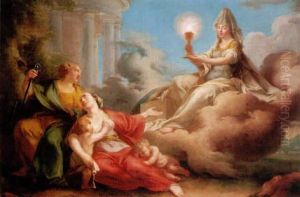Clement-Louis-Marie-Anne Belle Paintings
Clement-Louis-Marie-Anne Belle, born on October 25, 1722, in Paris, was a French historical painter whose career spanned the latter half of the 18th century, a period marked by significant political, social, and artistic changes leading up to the French Revolution. Belle came from an artistic family; his father, Alexis Simon Belle, was also a painter, and it was under his guidance that Clement received his initial training in the arts.
Developing his craft in an era when the Académie Royale de Peinture et de Sculpture wielded significant influence over the arts in France, Belle became a part of this institution's academic tradition. He was admitted to the Académie as a historical painter in 1754, and his reception piece, a painting titled 'The Israelites Gathering Manna in the Desert,' showcased his adherence to the academic standards of the time, which emphasized classical subjects, balanced compositions, and a polished finish.
Throughout his career, Belle was involved in various important commissions, many of which were for religious institutions. His works often featured religious and mythological themes, aligning with the tastes of his patrons and the expectations of the Académie. Belle's style was characterized by a refined elegance and a clear narrative quality, attributes that were highly prized in academic circles.
Despite his success and recognition, Belle's career and the academic tradition he represented eventually gave way to the rising tide of Neoclassicism. The latter part of the 18th century saw artists like Jacques-Louis David gain prominence, with a style that emphasized austerity and moral rigor over the decorative qualities favored by Belle and his contemporaries.
Belle's death on September 21, 1806, in Paris, came at a time when the art world he had known was undergoing profound transformations. The French Revolution had altered the landscape of patronage and taste, and the Napoleonic era that followed continued to redefine the role of the artist in society. Nonetheless, Belle's contributions to French art history, particularly within the confines of the academic tradition, remain a testament to his skills and the aesthetic values of his time.

